warning SAAB 9-5 2002 Owners Manual
[x] Cancel search | Manufacturer: SAAB, Model Year: 2002, Model line: 9-5, Model: SAAB 9-5 2002Pages: 272, PDF Size: 16.26 MB
Page 2 of 272
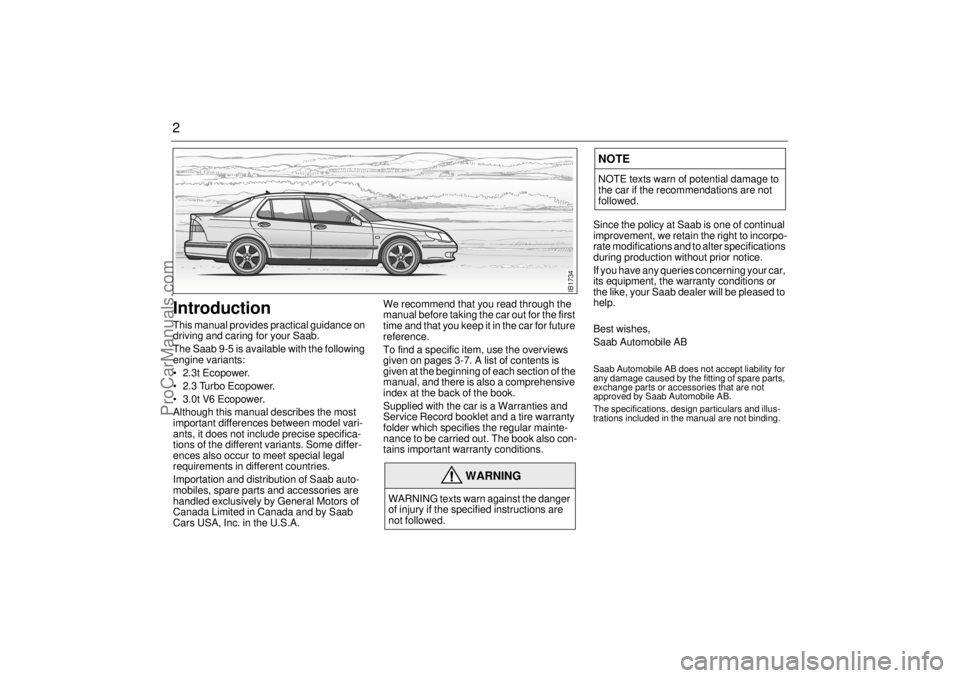
2Introduction This manual provides practical guidance on
driving and caring for your Saab.
The Saab 9-5 is available with the following
engine variants:
2.3t Ecopower.
2.3 Turbo Ecopower.
3.0t V6 Ecopower.
Although this manual describes the most
important differences between model vari-
ants, it does not include precise specifica-
tions of the different variants. Some differ-
ences also occur to meet special legal
requirements in different countries.
Importation and distribution of Saab auto-
mobiles, spare parts and accessories are
handled exclusively by General Motors of
Canada Limited in Canada and by Saab
Cars USA, Inc. in the U.S.A.We recommend that you read through the
manual before taking the car out for the first
time and that you keep it in the car for future
reference.
To find a specific item, use the overviews
given on pages 3-7. A list of contents is
given at the beginning of each section of the
manual, and there is also a comprehensive
index at the back of the book.
Supplied with the car is a Warranties and
Service Record booklet and a tire warranty
folder which specifies the regular mainte-
nance to be carried out. The book also con-
tains important warranty conditions. Since the policy at Saab is one of continual
improvement, we retain the right to incorpo-
rate modifications and to alter specifications
during production without prior notice.
If you have any queries concerning your car,
its equipment, the warranty conditions or
the like, your Saab dealer will be pleased to
help.
Best wishes,
Saab Automobile AB
Saab Automobile AB does not accept liability for
any damage caused by the fitting of spare parts,
exchange parts or accessories that are not
approved by Saab Automobile AB.
The specifications, design particulars and illus-
trations included in the manual are not binding.
WARNING
WARNING texts warn against the danger
of injury if the specified instructions are
not followed.
NOTENOTE texts warn of potential damage to
the car if the recommendations are not
followed.
IB1734
ProCarManuals.com
Page 3 of 272
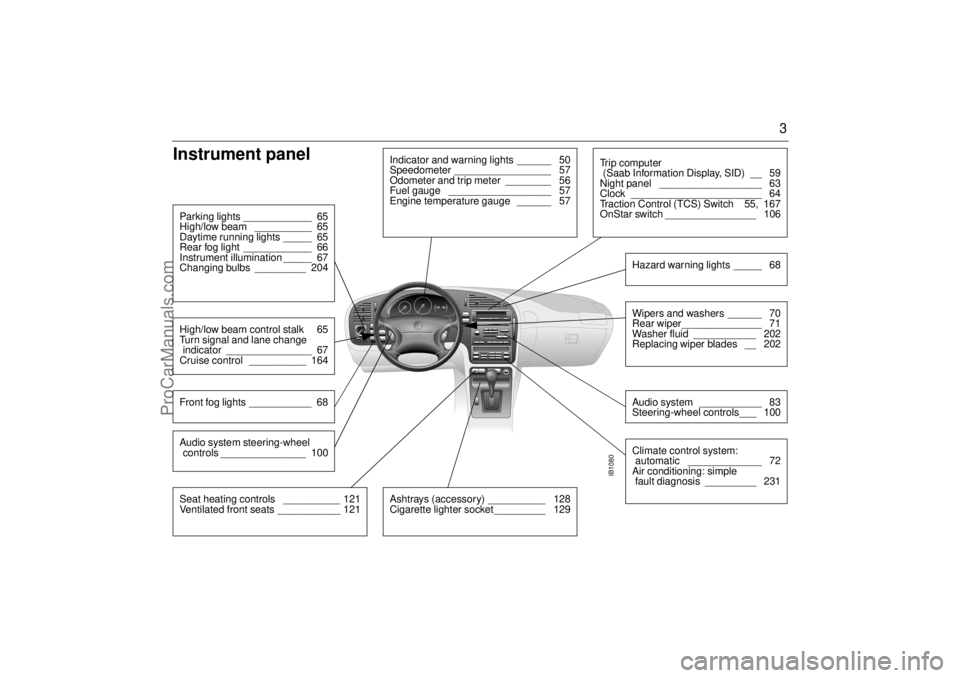
3
Instrument panel
IB1080
Indicator and warning lights ______ 50
Speedometer _________________ 57
Odometer and trip meter ________ 56
Fuel gauge __________________ 57
Engine temperature gauge ______ 57
Parking lights ____________ 65
High/low beam __________ 65
Daytime running lights _____ 65
Rear fog light ____________ 66
Instrument illumination _____ 67
Changing bulbs _________ 204High/low beam control stalk 65
Turn signal and lane change
indicator _______________ 67
Cruise control __________ 164Front fog lights ___________ 68
Ashtrays (accessory) __________ 128
Cigarette lighter socket _________ 129
Tr i p c o m p u t e r
(Saab Information Display, SID) __ 59
Night panel __________________ 63
Clock _______________________ 64
Traction Control (TCS) Switch 55, 167
OnStar switch ________________ 106
Wipers and washers ______ 70
Rear wiper ______________ 71
Washer fluid ___________ 202
Replacing wiper blades __ 202Audio system ___________ 83
Steering-wheel controls___ 100Hazard warning lights _____ 68Climate control system:
automatic _____________ 72
Air conditioning: simple
fault diagnosis _________ 231
Seat heating controls __________ 121
Ventilated front seats ___________ 121Audio system steering-wheel
controls _______________ 100
ProCarManuals.com
Page 6 of 272
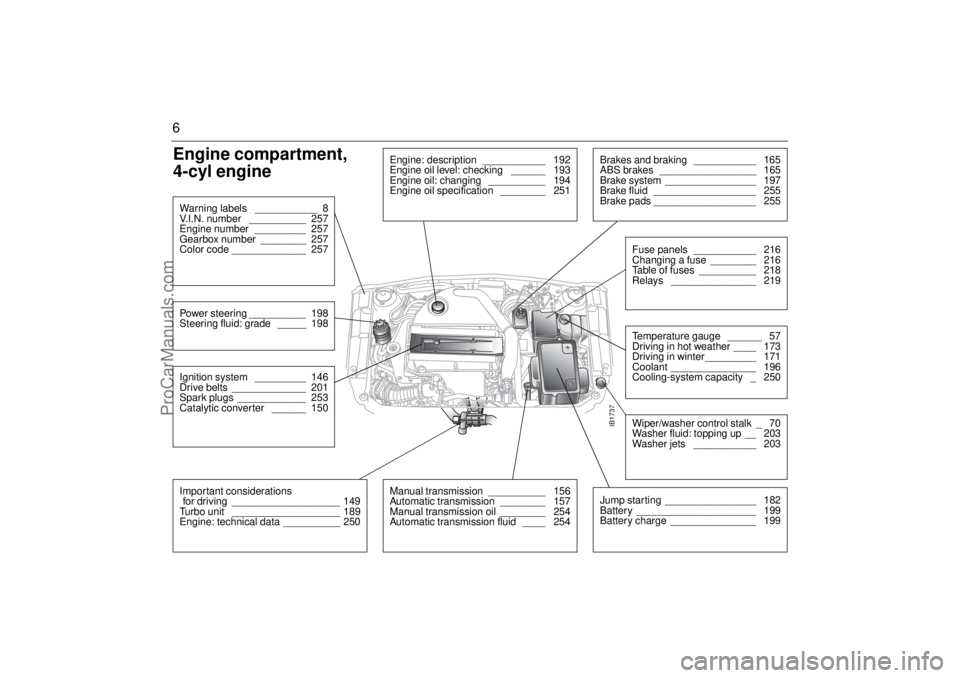
6Engine compartment,
4-cyl engine
IB1737
Engine: description ___________ 192
Engine oil level: checking ______ 193
Engine oil: changing __________ 194
Engine oil specification ________ 251
Brakes and braking ___________ 165
ABS brakes _________________ 165
Brake system ________________ 197
Brake fluid __________________ 255
Brake pads __________________ 255
Fuse panels ___________ 216
Changing a fuse ________ 216
Table of fuses __________ 218
Relays _______________ 219Temperature gauge ______ 57
Driving in hot weather ____ 173
Driving in winter_________ 171
Coolant _______________ 196
Cooling-system capacity _ 250
Power steering __________ 198
Steering fluid: grade _____ 198
Wiper/washer control stalk _ 70
Washer fluid: topping up __ 203
Washer jets ___________ 203
Jump starting ________________ 182
Battery _____________________ 199
Battery charge _______________ 199
Manual transmission __________ 156
Automatic transmission ________ 157
Manual transmission oil ________ 254
Automatic transmission fluid ____ 254
Important considerations
for driving ___________________ 149
Turbo unit ___________________ 189
Engine: technical data __________ 250Ignition system _________ 146
Drive belts _____________ 201
Spark plugs ____________ 253
Catalytic converter ______ 150Warning labels ___________ 8
V.I.N. number __________ 257
Engine number _________ 257
Gearbox number ________ 257
Color code _____________ 257
ProCarManuals.com
Page 7 of 272
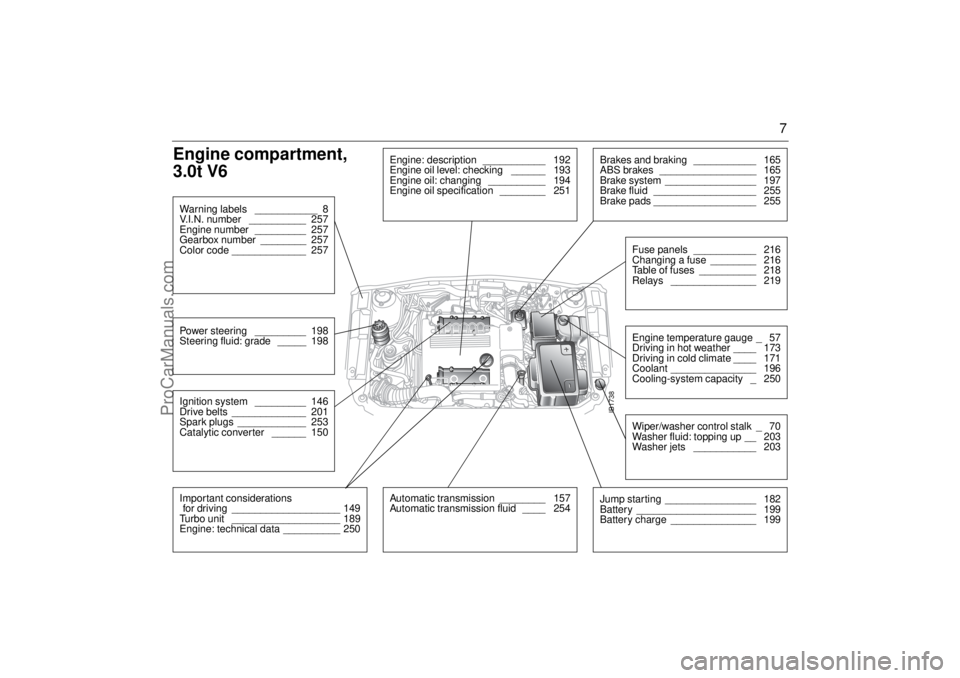
7
Engine compartment,
3.0t V6
IB1738
Warning labels ___________ 8
V.I.N. number __________ 257
Engine number _________ 257
Gearbox number ________ 257
Color code _____________ 257Ignition system _________ 146
Drive belts _____________ 201
Spark plugs ____________ 253
Catalytic converter ______ 150Important considerations
for driving ___________________ 149
Turbo unit ___________________ 189
Engine: technical data __________ 250
Automatic transmission ________ 157
Automatic transmission fluid ____ 254
Brakes and braking ___________ 165
ABS brakes _________________ 165
Brake system ________________ 197
Brake fluid __________________ 255
Brake pads __________________ 255Jump starting ________________ 182
Battery _____________________ 199
Battery charge _______________ 199
Fuse panels ___________ 216
Changing a fuse ________ 216
Table of fuses __________ 218
Relays _______________ 219Engine temperature gauge _ 57
Driving in hot weather ____ 173
Driving in cold climate ____ 171
Coolant _______________ 196
Cooling-system capacity _ 250
Power steering _________ 198
Steering fluid: grade _____ 198
Wiper/washer control stalk _ 70
Washer fluid: topping up __ 203
Washer jets ___________ 203
Engine: description ___________ 192
Engine oil level: checking ______ 193
Engine oil: changing __________ 194
Engine oil specification ________ 251
ProCarManuals.com
Page 8 of 272
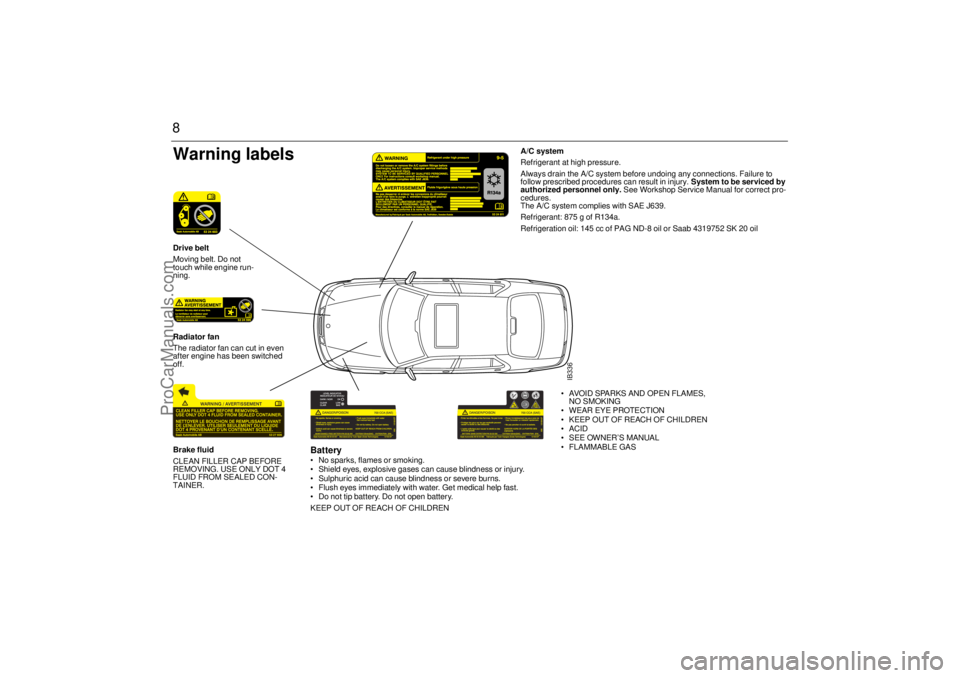
8
Battery No sparks, flames or smoking.
Shield eyes, explosive gases can cause blindness or injury.
Sulphuric acid can cause blindness or severe burns.
Flush eyes immediately with water. Get medical help fast.
Do not tip battery. Do not open battery.
KEEP OUT OF REACH OF CHILDREN Brake fluid
CLEAN FILLER CAP BEFORE
REMOVING. USE ONLY DOT 4
FLUID FROM SEALED CON-
TAINER. Radiator fan
The radiator fan can cut in even
after engine has been switched
off.
IB336
Drive belt
Moving belt. Do not
touch while engine run-
ning.
A/C system
Refrigerant at high pressure.
Always drain the A/C system before undoing any connections. Failure to
follow prescribed procedures can result in injury. System to be serviced by
authorized personnel only. See Workshop Service Manual for correct pro-
cedures.
The A/C system complies with SAE J639.
Refrigerant: 875 g of R134a.
Refrigeration oil: 145 cc of PAG ND-8 oil or Saab 4319752 SK 20 oil
Warning labels
AVOID SPARKS AND OPEN FLAMES,
NO SMOKING
WEAR EYE PROTECTION
KEEP OUT OF REACH OF CHILDREN
ACID
SEE OWNER’S MANUAL
FLAMMABLE GAS
ProCarManuals.com
Page 10 of 272
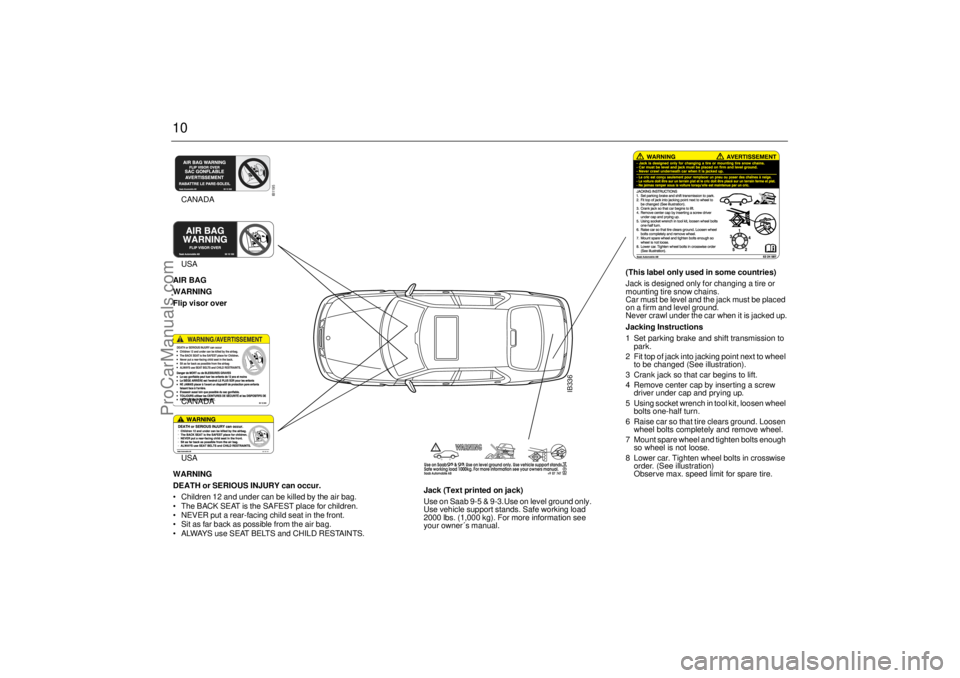
10
IB336
(This label only used in some countries)
Jack is designed only for changing a tire or
mounting tire snow chains.
Car must be level and the jack must be placed
on a firm and level ground.
Never crawl under the car when it is jacked up.
Jacking Instructions
1 Set parking brake and shift transmission to
park.
2 Fit top of jack into jacking point next to wheel
to be changed (See illustration).
3 Crank jack so that car begins to lift.
4 Remove center cap by inserting a screw
driver under cap and prying up.
5 Using socket wrench in tool kit, loosen wheel
bolts one-half turn.
6 Raise car so that tire clears ground. Loosen
wheel bolts completely and remove wheel.
7 Mount spare wheel and tighten bolts enough
so wheel is not loose.
8 Lower car. Tighten wheel bolts in crosswise
order. (See illustration)
Observe max. speed limit for spare tire.
Jack (Text printed on jack)
Use on Saab 9-5 & 9-3.Use on level ground only.
Use vehicle support stands. Safe working load
2000 lbs. (1,000 kg). For more information see
your owner´s manual.
IB994
IB1195
CANADAUSA
AIR BAG
WARNING
Flip visor overCANADA
50 10 111
USA
WARNING
DEATH or SERIOUS INJURY can occur.
Children 12 and under can be killed by the air bag.
The BACK SEAT is the SAFEST place for children.
NEVER put a rear-facing child seat in the front.
Sit as far back as possible from the air bag.
ALWAYS use SEAT BELTS and CHILD RESTAINTS.
ProCarManuals.com
Page 12 of 272
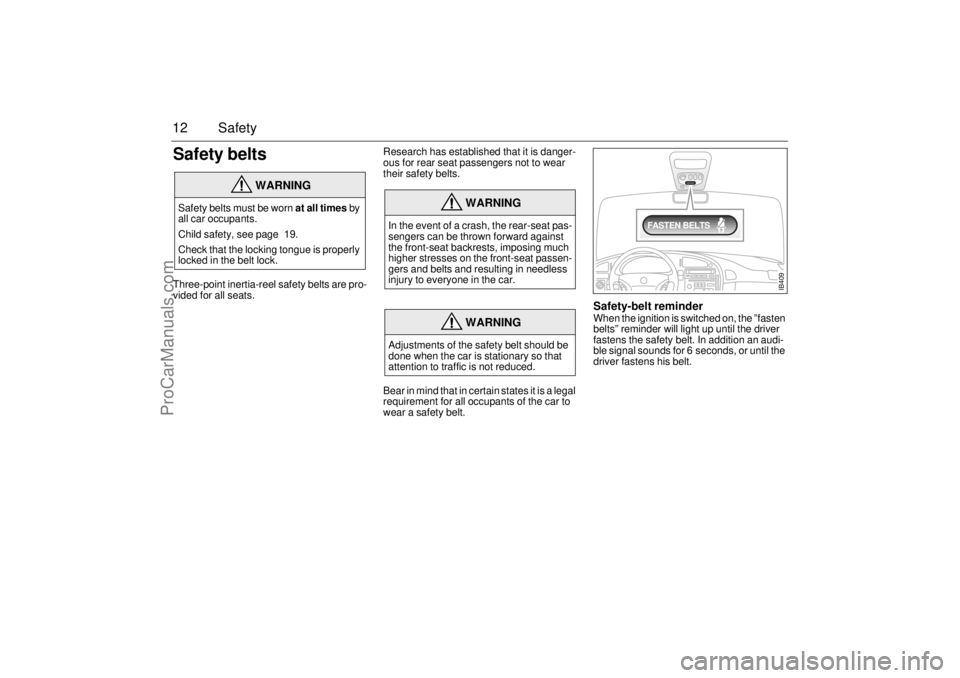
12 SafetySafety belts Three-point inertia-reel safety belts are pro-
vided for all seats. Research has established that it is danger-
ous for rear seat passengers not to wear
their safety belts.
Bear in mind that in certain states it is a legal
requirement for all occupants of the car to
wear a safety belt.
Safety-belt reminderWhen the ignition is switched on, the ”fasten
belts” reminder will light up until the driver
fastens the safety belt. In addition an audi-
ble signal sounds for 6 seconds, or until the
driver fastens his belt.
WARNING
Safety belts must be worn at all times by
all car occupants.
Child safety, see page 19.
Check that the locking tongue is properly
locked in the belt lock.
WARNING
In the event of a crash, the rear-seat pas-
sengers can be thrown forward against
the front-seat backrests, imposing much
higher stresses on the front-seat passen-
gers and belts and resulting in needless
injury to everyone in the car.
WARNING
Adjustments of the safety belt should be
done when the car is stationary so that
attention to traffic is not reduced.
IB409
FASTEN BELTS
ProCarManuals.com
Page 13 of 272
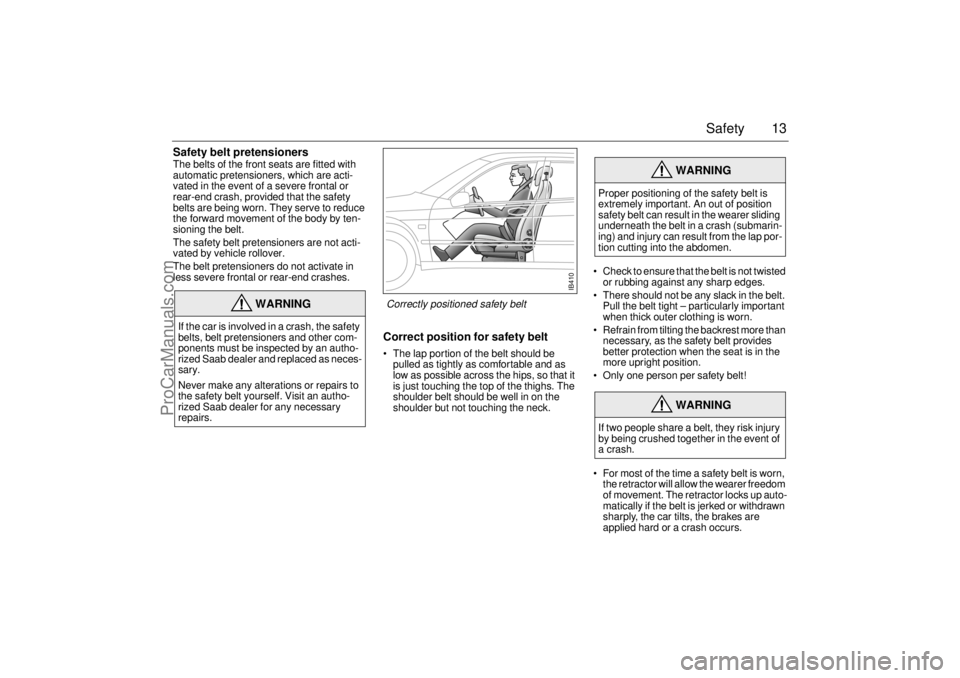
13 Safety
Safety belt pretensionersThe belts of the front seats are fitted with
automatic pretensioners, which are acti-
vated in the event of a severe frontal or
rear-end crash, provided that the safety
belts are being worn. They serve to reduce
the forward movement of the body by ten-
sioning the belt.
The safety belt pretensioners are not acti-
vated by vehicle rollover.
The belt pretensioners do not activate in
less severe frontal or rear-end crashes.
Correct position for safety belt The lap portion of the belt should be
pulled as tightly as comfortable and as
low as possible across the hips, so that it
is just touching the top of the thighs. The
shoulder belt should be well in on the
shoulder but not touching the neck.
Check to ensure that the belt is not twisted
or rubbing against any sharp edges.
There should not be any slack in the belt.
Pull the belt tight – particularly important
when thick outer clothing is worn.
Refrain from tilting the backrest more than
necessary, as the safety belt provides
better protection when the seat is in the
more upright position.
Only one person per safety belt!
For most of the time a safety belt is worn,
the retractor will allow the wearer freedom
of movement. The retractor locks up auto-
matically if the belt is jerked or withdrawn
sharply, the car tilts, the brakes are
applied hard or a crash occurs.
WARNING
If the car is involved in a crash, the safety
belts, belt pretensioners and other com-
ponents must be inspected by an autho-
rized Saab dealer and replaced as neces-
sary.
Never make any alterations or repairs to
the safety belt yourself. Visit an autho-
rized Saab dealer for any necessary
repairs.
WARNING
Proper positioning of the safety belt is
extremely important. An out of position
safety belt can result in the wearer sliding
underneath the belt in a crash (submarin-
ing) and injury can result from the lap por-
tion cutting into the abdomen.
WARNING
If two people share a belt, they risk injury
by being crushed together in the event of
a crash.
IB410
Correctly positioned safety belt
ProCarManuals.com
Page 14 of 272
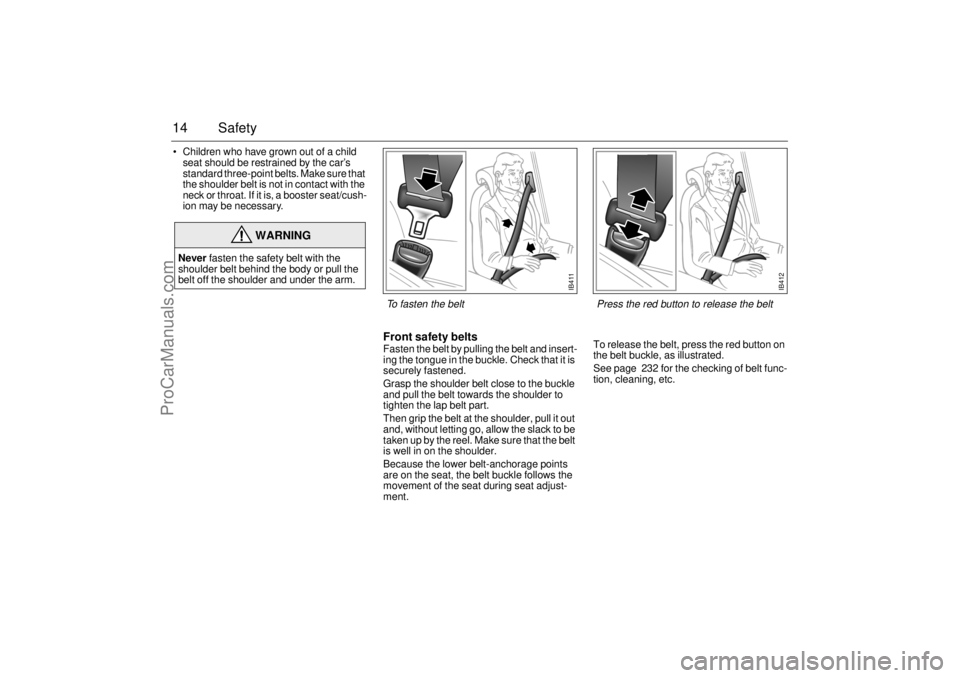
14 Safety Children who have grown out of a child
seat should be restrained by the car’s
standard three-point belts. Make sure that
the shoulder belt is not in contact with the
neck or throat. If it is, a booster seat/cush-
ion may be necessary.
Front safety belts Fasten the belt by pulling the belt and insert-
ing the tongue in the buckle. Check that it is
securely fastened.
Grasp the shoulder belt close to the buckle
and pull the belt towards the shoulder to
tighten the lap belt part.
Then grip the belt at the shoulder, pull it out
and, without letting go, allow the slack to be
taken up by the reel. Make sure that the belt
is well in on the shoulder.
Because the lower belt-anchorage points
are on the seat, the belt buckle follows the
movement of the seat during seat adjust-
ment.To release the belt, press the red button on
the belt buckle, as illustrated.
See page 232 for the checking of belt func-
tion, cleaning, etc.
WARNING
Never fasten the safety belt with the
shoulder belt behind the body or pull the
belt off the shoulder and under the arm.
IB411
To fasten the belt
IB412
Press the red button to release the belt
ProCarManuals.com
Page 16 of 272

16 SafetySafety belt, rear seat Three-point safety belts are provided for all
three rear seat passengers.
Fasten the belt by pulling out the strap care-
fully and inserting the tongue in the lock.
Check that it is securely fastened.
Then grip the diagonal part of the strap near
the lock and pull the belt upwards towards
the shoulder to tighten the lap strap. The lap
strap should lie low over the hips.
The diagonal part should lie as far in on the
shoulder as possible.
To release the belt, press the red button on
the belt lock.
See page 232 for the checking of belt func-
tion, cleaning, etc.
WARNING
Make sure that the belt does not
become trapped when the backrest is
folded down or raised (see page 132).
If a cargo has to be placed on a seat,
it must be properly secured with the
safety belt. This reduces the risk of
the cargo being thrown about during
hard braking or a possible crash,
which could cause personal injury.
Check that the belt is not twisted or
lying against sharp edges.
IB???IB415
Safety belt, rear seat
IB416
Securing an item on the rear seat
ProCarManuals.com